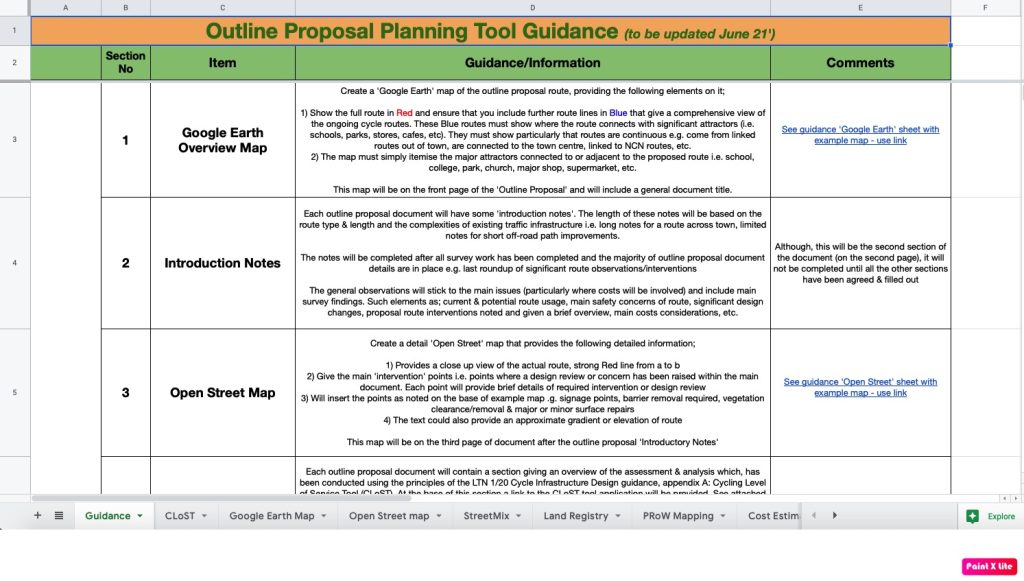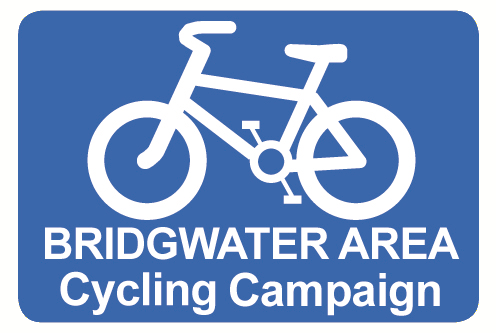BACC Feasibility Studies
- Wembdon Church Path Feasibility Study (2021)
- Bridgwater Liveable Neighbourhood Scheme (2022?)
To understand how we put these documents together and to provide an insight into the ‘Outline Planning Tool Guidance’ read on below..

Feasibility Study Tool
Feasibility studies are detailed documents based on national guidance provided within Cycle Infrastructure Design LTN 1/20 and mirror the Sustrans infrastructure feasibility reports.
BACC have devised a guidance tool (click image to open up the tool spreadsheet) to construct these reports; each element gives descriptive information of how each section’s information & graphics are constructed. Sections of each report are:
- Introductory notes,
- Cycling Level of Service Tool (CLoST),
- audit survey,
- route assessment & analysis’
- overview & detailed maps,
- street mix design concepts,
- land registry,
- Public Rights of Way (PROW),
- cost & risk assessment,
- route video and
- required actions & intervention recommendations.

Study Tool Information
This tool is only available to people that have knowledge of the Local Cycling & Walking Infrastructure Plan (LCWIP) ‘Technical Guidance for Local Authorities‘, particularly section 5 ‘Network Planning & Cycling Tool – Stage 3’. You must also have been trained in the auditing process (reference in section 5) using the ‘Route Selection Tool‘.
If you would like further details on this, please contact us at the usual email address: bridgwaterareacyclingcampaign@gmail.com
The following text provides you with a very brief overview and an insight into the main outcome of the reporting tool — the Interventions.
Introduction
Each outline proposal document (feasibility study) will have some ‘overview notes’. The length of these notes will be based on the route type and length, and the complexities of existing traffic infrastructure (i.e. long notes for a route across complex areas of town, limited notes for short off-road safer path improvements).
The notes will be completed after all audit survey work has been done and the majority of outline proposal document details are in place.
The general audit observations will stick to the main issues (particularly where costs will be involved) and include main survey findings. Such elements as:
- current and potential route usage;
- main safety concerns of route;
- significant design changes;
- proposal route interventions;
- main cost considerations.
The ‘Route Assessment & Analysis’ section is based on data information from the audit survey using the CLoST tool. This section’s main elements are:
- Cohesion;
- Directness;
- Safety (major part);
- Comfort; and
- Attractiveness.
The Interventions
These are examples of interventions that need to be considered. Can you think of others?
- Path widening or resurfacing — i.e. suitable for all users, disabled, pushchairs, etc.
- Path edge design & safety — i.e. kerb stones, wood edges, safety fences, etc.
- Major new infrastructure required — e.g. crossing, junction, bridge, reroute path.
- Segregation type barrier from traffic required — e.g. fixed kerbs, armadillos, route posts, railings.
- Required shared-use or mixed route path markings. Separate cyclists and pedestrians or mix?
- Any barrier/post/railings/chicane removal or repairs required.
- Alteration to existing route signage or additional signage required.
- Reduction and recommendation in speed limits.
- Alterations, renewal, repair of existing gates, fences and access & egress routes
- Necessary maintenance and/or removal of vegetation.
- Addition or improvements to cycle parking and security.
